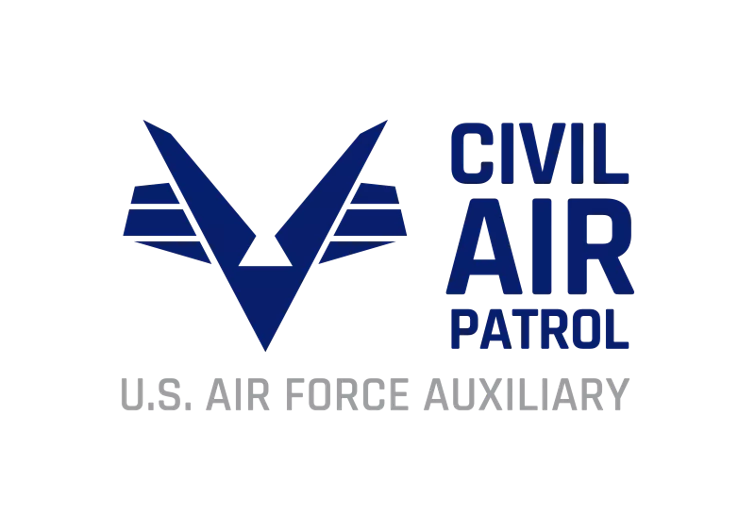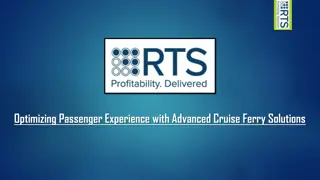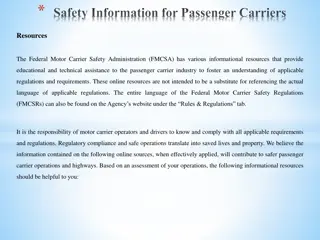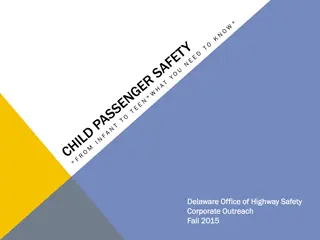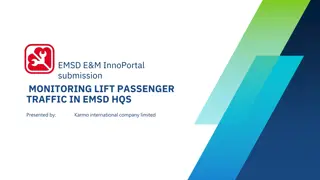Passenger Van Safety Awareness Program
Increase safety awareness for passenger van drivers to reduce accident risks, especially rollovers. Topics cover NHTSA reports, driving procedures, safety agencies, and unique features of Civil Air Patrol vans. Emphasizes the importance of careful driving, proper loading, and seat belt use to prevent accidents and rollovers.
Download Presentation

Please find below an Image/Link to download the presentation.
The content on the website is provided AS IS for your information and personal use only. It may not be sold, licensed, or shared on other websites without obtaining consent from the author.If you encounter any issues during the download, it is possible that the publisher has removed the file from their server.
You are allowed to download the files provided on this website for personal or commercial use, subject to the condition that they are used lawfully. All files are the property of their respective owners.
The content on the website is provided AS IS for your information and personal use only. It may not be sold, licensed, or shared on other websites without obtaining consent from the author.
E N D
Presentation Transcript
Passenger Van Safety Awareness Program 1 1
Course Objective & Outline The objective of this presentation is to increase the safety awareness of passenger van drivers, thus reducing the risk of accidents, especially rollovers. Outline: NHTSA Report Overview General Accident Facts 15-Passenger Van Facts Driving Procedures and Tips NSA Annapolis/USNA Policy Check-Out Procedures
Safety Agencies National Highway Transportation Safety Administration NSC
Civil Air Patrol Vans Unique to CAP vans Civil Air Patrol has removed the last row of seats and provided cargo netting for all 15 passenger capable vehicles Civil Air Patrol vans should NOT be loaded beyond cargo net limitations Overloading may result in the same out of balance situation as if the last row of seats were installed. Reference CAPR 77-1, Operation and Maintenance of CAP Vehicles, for more information.
NHTSA Report on Safety 15-passenger vans have an INCREASED ROLLOVER RISK under certain conditions: When the number of occupants increases from fewer than 5 occupants to over 10 passengers Having 10 or more occupants increased the rollover rate 5 times for a single vehicle crash The way a 15-passenger van is loaded can causes the center of gravity to shift rearward and upward, increasing the likelihood of rollover and will also increase the potential for loss of control in panic maneuvers. Any load placed on the roof will be above the center of gravity of the vehicle and will increase the likelihood of rolling over. It is important that the van be operated by experienced drivers. They should understand and be familiar with the handling characteristics of their vans, especially when fully loaded. Institutions using 15-passenger vans should always require seat belt use.
Driving Tips All Vehicles in CAP Always drive conservatively Avoid excessive speed and abrupt maneuvers Don t drive tired Don t drive in bad weather, if possible Take rest breaks often (every 2 hours is recommended) Wear seat belts always, when the vehicle is in motion Drive only during the day, if possible Require someone to be awake in the front seat with the driver on long trips
Driving Tips 15 Passenger Vans A speed that may be acceptable in a car could be dangerous in a van As the van is loaded with passengers, the center of gravity shifts upward above the wheels. The higher the number of passengers, the greater the likelihood of a rollover, as more weight shifts towards the rear Always fill the front seats first The shift in the center of gravity will also increase the potential for loss of control in panic maneuvers Soft shoulders and culverts pose a hazard in rural areas Keep a safe distance between others longer stopping distance
Driving Tips Caravan Trips Radio or phone communications should be established between vehicles on multi- vehicle trips. Use of cellular phones while driving CAP vehicles is not permitted Trip leader to drive lead vehicle and set the pace. . . no other vehicle shall pass Make sure to keep a safe distance between vehicles Trip leader should communicate the planned driving route to all other drivers
Accident Facts 25% of all driving accidents are the result of excessive speed 60% of van rollovers are the result of under-inflated tires 70% of driving accidents occur within 25 miles from home 25% of employees who drive as a part of their jobs experience an accident while at work
Accident Facts Safety Belts! According to the NHTSA, 80% of people killed in rollover crashes were not wearing their safety belt Many injuries and deaths attributed to large vans are a result of ejection. Once vans begin to roll over, many people are killed because they did not use seatbelts
Passengers Picking Up & Dropping Off Pull off to a non-congested area with excellent visibility If possible, avoid pick-up and drop off locations where passengers must cross a street or highway If passengers must cross a roadway, do not wave them across the road in front of your van. Pedestrians should cross at a crosswalk or other controlled area and make their decision on when to safely proceed
Defensive Driving Drive with courtesy Stay calm when driving Concentrate - Use reference points to ensure vehicles stays on pavement and in the correct lane Drive cautiously, leaving a safety cushion between your vehicle and others to avoid having to make sudden maneuvers
Dealing with Aggressive Drivers Avoid eye contact Don t cut in front of other drivers Allow fellow drivers to merge, while keeping a safe distance Don t aggravate fellow drivers with hand gesture Never tailgate Use your horn sparingly Give aggressive drivers plenty of space to move on without provocation
Backing the Van Use a spotter if possible Make an allowance for the extended length of the van behind the rear wheels Back to the left (driver s side) Never back up if you miss a ramp/exit. Go to the next exit and return to your intended exit Use (properly adjusted) outside mirrors. (adjusted outward so you can see your blind spots)
Side-View Mirrors How to adjust them In a normal seating position, you should not be able to see any part of your own vehicle in the side-view mirrors. Adjust the side-view mirrors just beyond the How to Properly Set Your Side Mirrors - YouTube point where you could see the side of the car on the inside edge of the mirror.
Safe Following Distance How to determine a safe following distance? Look for a land mark alongside the road, such as, a road sign or the dotted lines on the road When the vehicle in front of you passes the landmark count four seconds by saying: one thousand one, two thousand two, one thousand three, one thousand four If you reach the mark before you have finished counting to 4, you are too close. In bad weather, add 1-2 seconds Always make sure there is enough space in front of you and behind you to give you time to react to problems If someone overtakes you, readjust your following distance
Highway Driving When driving a passenger van, avoid lane changes unless necessary Always use your signals with ample notice to other drivers Merges: Signal and move steadily into the drive-lane. Don t cut off other vehicles Blind Spots: Never cruise in another vehicle s blind spot! If the other driver cannot see you, the driver may attempt a lane-change, causing you to make an abrupt avoidance maneuver which can result in loss of control of the van and potential rollover When changing lanes, use both mirrors and a brief head-turn back. Have the front seat passenger assist you, if needed.
Highway Driving Driving a CAP van means you are driving a longer, heavier vehicle. While driving on a highway or open road it's your responsibility to be aware of and avoid situations which may result in the loss of control. Watch the road at least of a mile ahead. Drive slower and leave an ample clearance between your vehicle and others, so that you can avoid abrupt maneuvers and/or hard breaking. Stopping in a straight line is usually the best option. Avoid swerving as that increases a risk of a rollover.
Highway Driving Slow Moving Vehicles Allow more distance than usual, as slow-moving drivers are likely to brake suddenly or make unexpected maneuvers Also, allow more distance if you are being tailgated. This will enable you to stop more gradually if the driver in front of you stops suddenly Pass with caution. Again, a slow driver may make an unexpected move which could result in an abrupt maneuver on your part
Highway Driving Entrance & Exit Ramps Rollovers can be caused by excessive speed while turning on the ramps on and off the highway Posted speed limits on ramps are intended for cars, slow your van to 5 miles-per-hour below the posted speed limit on ramps
Hydroplaning At speeds as low as 30 mph, the tires start to ride up on a film of water like water skis. This is called hydroplaning At 55 mph, the tires may be totally up on the water In a rainstorm, tires may lose all contact with the road at 55 mph. If this is the case, there is no friction to brake, speed up, or corner. A gust of wind, a change of road level, or a slight turn can create a skid To avoid hydroplaning, you must slow down in heavy rain, standing water or slush on the road Do not drive on bald or badly worn tires
Things to watch out for City & Rural Areas Bicyclists Pedestrians Slow Agricultural Vehicles Deer Soft Shoulders Culverts Curves, Hills and Narrow Roads Stop signs / lights Yield Signs Signals Blind spots Vehicles entering your drive-lane from parking spaces or side streets and alleys Motorcycles (Attempting to avoid hitting small animals is not recommended It's better to repair front-end damage than roll over)
If your wheels leave the pavement Never attempt to correct the van while maintaining your speed. Due to the weight of the van, inertia will cause the rear-end to try to overtake the front (fishtail). You will lose control of the van and will likely roll Slow down (to a near-stop if necessary) before righting the vehicle
Accident Procedures Never leave the scene of an accident Report the accident to the police Never admit fault. Provide information to the emergency response personnel, i.e., Police and EMTs Gather all the facts and take many pictures (date, time, witnesses, phone numbers, etc.) Immediately report all accidents to your chain of command and the CAP National Operations Center
Summary Vans are not cars and don t handle like cars Inspect your van before each trip, including all controls, signals & tire pressure (Critical!) Load your passengers from front to rear Ensure all passengers are correctly wearing their safety belts Do not exceed posted speed limits. Drive 5 mph slower than the posted limit on entrance/exit ramps and sharp curves Maintain a cushion of safety between your van and vehicles in front of and around you Allow more distance between you and the vehicle in front than you would if your were driving a car. Following distances, this means being able to count to 4 between the vehicle in front and your van using a fixed reference point Stay out of other driver s blind spots. Be aware of cars entering or cruising in your blind spots In inclement weather conditions, allow more distance than normal, at least 5 6 seconds from a fixed reference point If your tires leave the paved road surface, re-enter the pavement very slowly to avoid losing control of your van
Thank You! Thank You for taking the time to complete this training presentation! As a professional driver, you are responsible for the safety of your van passengers. For More Information: Civil Air Patrol National Safety Team safety@capnhq.gov







